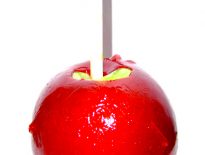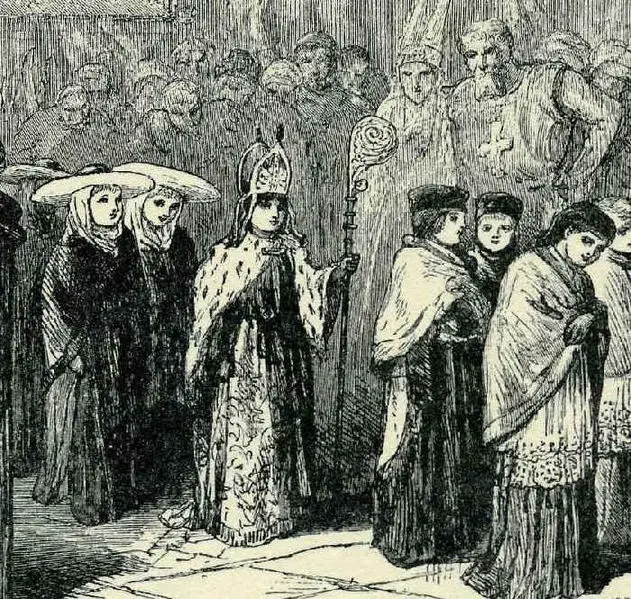Advent
 The four weeks of Advent began on Advent Sunday, the fourth Sunday before the Nativity, and was a time of fasting, i.e. abstaining from meat. Christmas Eve was even stricter than the rest of advent, with no meat, cheese or eggs being eaten, until after midnight mass when it was officially Christmas Day.
The four weeks of Advent began on Advent Sunday, the fourth Sunday before the Nativity, and was a time of fasting, i.e. abstaining from meat. Christmas Eve was even stricter than the rest of advent, with no meat, cheese or eggs being eaten, until after midnight mass when it was officially Christmas Day.
24 December – Christmas Eve
On Christmas Eve, a log known as the Yule log was brought into the home. The yule log tradition dates back to Tudor times, although it is thought that the tradition has its roots in the midwinter rituals of the early Vikings who built huge bonfires for their festival of light. The men of the house would go out to the local forest on Christmas Eve, find a huge log, decorate it with ribbons and drag it home to burn throughout the twelve days of Christmas. It was a central part of the Christmas festivities, as the family would gather around the hearth, and the men bringing in the log would be welcomed with hot spiced ale by the women of the house. People thought it was lucky to keep some charred remains of the Yule log to light the next year’s Yule log.
The chocolate Yule Logs that we see in the shops at Christmas time are a reminder of this old tradition.
25 December – Christmas Day and the start of the Twelve Days of Christmas
The fasting of advent was now over and this was a day to celebrate. Christmas Day was the first day of the Twelve Days of Christmas. Work for those who worked on the land would stop and spinners were banned from spinning. Work would not start again until Plough Monday, the first Monday after Twelfth Night. The Twelve Days of Christmas were a time for communities to come together and celebrate. People would visit their neighbours and friends and enjoy the Christmas traditions.
Christmas Day was a day to celebrate the coming of Jesus Christ, our Saviour, and the religious celebrations would begin first thing with a mass before dawn and then two further masses later in the day. Congregations held lighted tapers as the genealogy of Christ was sung, before heading home to enjoy a festive feast.
Christmas was a time to 'eat, drink and be merry', a time to celebrate and enjoy a little luxury. Those families who could afford a Christmas feast would celebrate it in style with foods like roast goose, turkey or beef, and Brawn and Mustard (roast wild boar with mustard). Turkey had been eaten at Christmas by some people during Henry VIII's reign, as it was introduced into England in the 1520s, but it had not yet superseded goose which was still the traditional meat of Christmas Day for those who could afford it. In 1588, Elizabeth I ordered the whole of England to eat goose for their Christmas Dinner to celebrate England's victory over the Armada because it was the first meal she ate after the Navy had defeated Spain's ships.
Accompaniments to the roast meat included plum porridge, mince pies and frumenty, a pottage made from boiled, cracked wheat. The Christmas meal was washed down with plenty of ale.
Richer households would have a more luxurious Christmas banquet which could include roasted swan or peac*ck which were displayed as table centrepieces with their feathers and skins put back on. A boar's head may also be used as a table decoration. These centrepieces showed just how rich the householder was. With the discovery of the New World and the Elizabethan voyages to America, the rich were also able to make use of new and exotic fruit and vegetables in their Christmas banquet. Tomatoes and potatoes were mixed with foods like citrus fruits which were specially imported from Southern European countries.
There was also the Tudor Christmas pie. This was a coffin shaped pie crust containing a turkey stuffed with a goose, which was stuffed with a chicken, which was stuffed with a partridge, which was stuffed with a pigeon.
The banqueting or sweet meat course was another way in which the host of the Christmas feast could flaunt their wealth, their status and their creativity. They would have already impressed their visitors with their roast meats and now they would use sweet delicacies to do the same. Sugar was a luxury cooking ingredient in Tudor times and was rather expensive, so an array of sweet delicacies would impress the guests. Delicacies on display would have included:
- Leech - A sweet made from milk, sugar and rose-water, which was cut into cubes. It was then displayed as a chequerboard, with some of the leech left plain and other cubes gilded.
- Collops of Bacon - A collop was a rasher of bacon but these collops were crafted from ground almonds and sugar, a bit like our present day marzipan.
- Sugar-plate - Sugar-plate was made from sugar, egg white and gelatin, and then crafted to look like walnuts, eggs and other food items.
- Gilded fruit - Fruit like lemons were gilded and used to decorate the banquet table.
- The Marchpane - This arrangement made from almond paste which was iced or gilded and then decorated with sugar figures and crystallised fruit, was the centrepiece of this course.
As well as the roast meats and sweet delicacies, well-to-do Elizabethans would have enjoyed:
- Christmas pudding - A "pudding" made from meat, spices and oatmeal and then cooked in the gut of a boar.
- Brussels Sprouts - The wonderful Brussels Sprout made its debut in England in the late 1580s.
- Gingerbread - Made from bread, ginger, spices, sugar and wine. This made a stiff paste which was then moulded.
- Mulled wine - Wine heated and infused with sugar and spices.
- Syllabub - A hot milk drink flavoured with rum or wine and spices.
- Lambswool - A drink made from mixing hot cider, sherry or ale, apples and spices. The mixture was heated until it "exploded" and formed a white "woolly" head.
- Tarts and custards for dessert.
- Quince marmalade
Other Christmas traditions included:
- The Christmas “minced pye” - This special pie contained thirteen ingredients, to symbolise Jesus and his apostles. It was a rectangular, or crib shaped, pie as opposed to our present day round ones, and it also contained minced meat rather than just dried fruit and suet, with the mutton symbolising the shepherds to whom the Angel Gabriel appeared.
- The Lord of Misrule - A commoner would be chosen as "The Lord of Misrule" and would be in charge of organising the entertainment and revelry for the Twelve Days of Christmas.
- Mummer's Plays with music and morris dancing.
- Decorating with greenery - Holly, ivy and other winter greenery would be brought inside the homes to decorate it.
- Christmas Carols - Christmas carols were sung on Christmas Eve and Christmas morning around the parish and carollers would be rewarded with money, food or drink.
- Wassailing - The enjoying of a communal cup of spiced ale. Wassailing has also been linked to blessing the orchards and land, and going round the parish in groups with an empty bowl for householders to fill with spiced ale.
26 December – Feast of St Stephen
The day after Christmas, which is today known as Boxing Day, was the feast day of St Stephen, the first Christian martyr or protomartyr. Stephen was stoned to death after being accused of blasphemy and his death was witnessed by Paul the Apostle, then known as Saul of Tarsus.
Thomas Tusser, the 16th century poet and farmer, wrote of how St Stephen's Day was the traditional day for bleeding horses and cattle:
Ere Christmas be passed let horse be let blood,
for many a purpose it doth them much good.
The day of St. Stephen old fathers did use:
if that do mislike thee some other day choose.
And it was also a day associated with hunting. On one St Stephen's Day, at the Inner Temple, a cat and fox were let loose and hunted with a pack of hounds who finally tore the two creatures to bits.
Trivia: “Boxing Day” has its origins in the 17th century when apprentices and servants collected their annual tips (gratuities) in boxes or earthenware pots.
28 December – Childermas
Childermas (Children’s Mass) or Holy Innocents’ Day was part of the Twelve Days of Christmas celebrated in the Tudor period and was celebrated on 28th December.
This feast day commemorates the massacre of the baby boys which King Herod ordered in Bethlehem, in an attempt to kill the infant Jesus Christ. The innocent babies were seen by the Catholic Church as the very first martyrs.
The 16th century Christmas carol, The Coventry Carol, which was sung on 28th December, referred to the massacre:
Herod the King, in his raging,
Charged he hath this day;
His men of might, in his own sight,
All children young, to slay.
The story of the massacre of these babies is told in the Gospel of Matthew. Herod asked the “Wise Men” to go and search for the Christ child and then to return to him: “bring me word again, that I may come and worship him also.” However, the Wise Men were warned in a dream not to return to Herod:
“Then Herod, when he saw that he was mocked of the wise men, was exceeding wroth, and sent forth, and slew all the children that were in Bethlehem, and in all the coasts thereof, from two years old and under, according to the time which he had diligently enquired of the wise men.
Then was fulfilled that which was spoken by Jeremy the prophet, saying,
In Rama was there a voice heard, lamentation, and weeping, and great mourning, Rachel weeping for her children, and would not be comforted, because they are not.” (Matthew 2: 16-18, Standard King James Version)



Leave a Reply